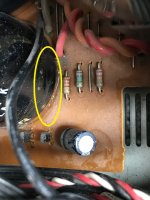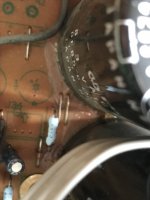Hello all,
These are photos from my Pioneer A66X. How concerned should I be?
I think it still sounds good but I have aged so my hearing probably isn't quite what it was.
Tempted to try a recap myself but that would be my first PCB soldering since I did C&G224 some 30 years ago and there is a lot to dismantle to get at the bottom of the board - nothing that lots of pictures would prevent me from putting back together.
Is this worth a recap or should I be looking at a newer amp?
Also notice that 4 transistors are running quite hot but do note these are not the main outbut transistors; those are mounted on the bottom of the huge heatsink.
Please be gentle.
These are photos from my Pioneer A66X. How concerned should I be?
I think it still sounds good but I have aged so my hearing probably isn't quite what it was.
Tempted to try a recap myself but that would be my first PCB soldering since I did C&G224 some 30 years ago and there is a lot to dismantle to get at the bottom of the board - nothing that lots of pictures would prevent me from putting back together.
Is this worth a recap or should I be looking at a newer amp?
Also notice that 4 transistors are running quite hot but do note these are not the main outbut transistors; those are mounted on the bottom of the huge heatsink.
Please be gentle.
Attachments
Last edited:
That is glue used to mechanically secure the caps rather than leakage. So all good with regard to that.
The transistors running hot are not in themselves a problem but they should be checked for deteriorated soldering (dries) on the leads.
Whether you recap it or not is up to you but just be aware that we sadly see many such projects here where something untoward happens and the amp ends up faulty.
If you do attempt it then make sure to take pictures and make notes of which way around the caps are fitted. Do not automatically rely on board markings.
If your soldering skills are less than perfect then practice first on something else.
The transistors running hot are not in themselves a problem but they should be checked for deteriorated soldering (dries) on the leads.
Whether you recap it or not is up to you but just be aware that we sadly see many such projects here where something untoward happens and the amp ends up faulty.
If you do attempt it then make sure to take pictures and make notes of which way around the caps are fitted. Do not automatically rely on board markings.
If your soldering skills are less than perfect then practice first on something else.
Mooly thank you for the swift responce. Not knowing that was glue shows my inexperience. I guess this amp is now 30+ years old - should a recap be considered as “maintenance task” or should it be left alone or is that a “how long is a piece of string” question and how do you break the glue bond without damaging the board?
The reason I opened it was to see how easy / hard to convert to motorised volume pot but have decided against that.
If I thought about paying for recap to be done how would I find a recommended engineer somewhere around north Wilts.
The reason I opened it was to see how easy / hard to convert to motorised volume pot but have decided against that.
If I thought about paying for recap to be done how would I find a recommended engineer somewhere around north Wilts.
It is a bit 'how long is apiece of string' because the caps may well all be just fine. Without measuring them properly (which is more than just the value of them) there is no way to know.
The glue will just crack/break or peel when you remove the cap. Depending on how they are soldered and whether the leads are bent would determine how they are removed.
Taking that cap in the third picture for example you could use solder braid and a good hot iron to quickly remove the solder. The leads would then be free and the part would pull out.
A method I would probably use and knowing a cap was to be replaced would be to heat on lead while at the same time applying significant sideways force to the cap. That one lead would free and then you do the other the same... it all comes with practice 🙂 Then use braid to ensue the hole was clear.
Time to remove a cap like that from first contact of the iron would be around 5 seconds.
Practice practice practice on something scrap first 😉
(no real idea how you would find someone local tbh)
The glue will just crack/break or peel when you remove the cap. Depending on how they are soldered and whether the leads are bent would determine how they are removed.
Taking that cap in the third picture for example you could use solder braid and a good hot iron to quickly remove the solder. The leads would then be free and the part would pull out.
A method I would probably use and knowing a cap was to be replaced would be to heat on lead while at the same time applying significant sideways force to the cap. That one lead would free and then you do the other the same... it all comes with practice 🙂 Then use braid to ensue the hole was clear.
Time to remove a cap like that from first contact of the iron would be around 5 seconds.
Practice practice practice on something scrap first 😉
(no real idea how you would find someone local tbh)
Nooly. Thank for your advice and patience. So nice my night classes (remember when they were affordable for all) work has got in the way of my hobby. Time for that to change now.
I’ll find an old, unloved, cheap amp (is there such a thing now) and do some practicing, relearning on my amp isn’t what it intend to do. After that my Linn Axis MB has suffered the typical fate so that also needs upgrade or repair.
I’ll find an old, unloved, cheap amp (is there such a thing now) and do some practicing, relearning on my amp isn’t what it intend to do. After that my Linn Axis MB has suffered the typical fate so that also needs upgrade or repair.
Output devices do/can run hot normally, but it could also indicate the bias adj is up the shoot, and this can be down to having been maladjusted by a pot twiddler or a faulty component, which can include fatigued caps (not the main reservoirs), also dried up heat sink compound.
To do a proper job you need to investigate and attend to all these areas
To do a proper job you need to investigate and attend to all these areas
Those hot-running transistors on the small heat sinks are not the output transistors - they could be drivers, VAS stage, or voltage regulators. The tendency is to use a heat sink that’s just big enough, having the transistor run at 65 to 75C case temperature. Biggest problem isn’t what happens to the transistor itself - but it’s surroundings get cooked from running like that for decades. The PCB becomes brittle, and solder joints get oxidized, and nearby capacitors get dried out. Resolder anything nearby that looks suspicious, as well as any small electrolytics that are within weapons range. You could try to upgrade the heat sinks, but often you’ll do more damage that it’s worth trying to get it apart. If the transistors had gone BAD and NEED replacement, I would advise attempting a better heat sink solution. But don’t mess with what’s not broken.
- Home
- Amplifiers
- Solid State
- Newby - Pioneer A66 Caps leaking?




